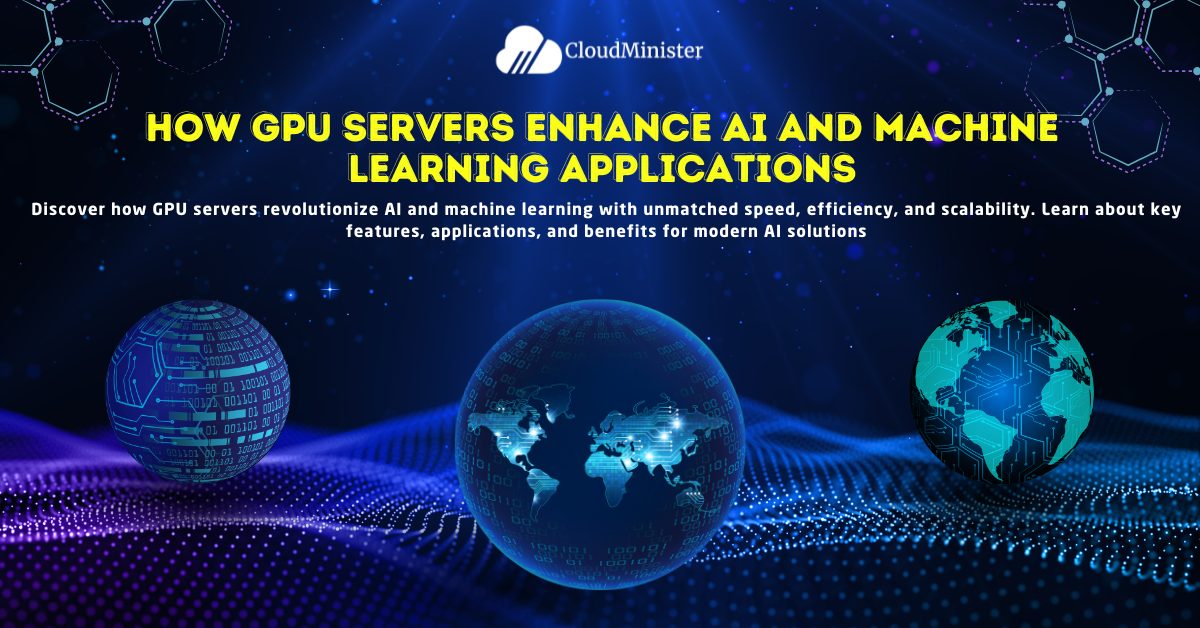AI and ML are the most profound changes in the world of technology. Their applications are in healthcare, finance, retail, and autonomous vehicles. The computational power required makes GPU servers crucial in modern AI development. This is because they are not built like normal servers that work solely on CPU; instead, they are designed specifically to process massive parallel processing in AI and ML workloads.
Why GPUs Are the Need of the Hour for AI and ML?
The primary purpose of designing GPUs was graphics rendering in gaming and video production. However, their ability to process multiple tasks simultaneously has made them crucial for computational tasks in AI and ML. Traditional CPUs are optimized for sequential tasks, but GPUs are better at parallel processing, which allows them to execute data-intensive algorithms faster.
The importance of GPU servers to AI development can be described through their ability:
Training Time Reduced: Deep learning model training mainly includes processing huge datasets. In comparison, GPU servers can do this efficiently by reducing training time from weeks to days.
Accuracy in the Models Improved: Computation at high speed enables iteration and optimization processes multiple times that improve the model accuracy.
Support Scalable Solutions: The integration of multiple NVIDIA server GPUs into a single machine provides scalability to meet growing computational demands.
Key Features of GPU Servers
The GPU server architecture makes them perfectly fit for AI and ML tasks. The following are some of the key features:
Massive Parallelism – A single GPU for servers can process thousands of threads in parallel, which is ideal for neural networks and other such AI algorithms.
High Memory Bandwidth – GPU servers offer considerable more memory bandwidth than those provided by CPUs, which enables better data transfer for large-scale computations.
Optimized libraries—Optimized libraries exist for using NVIDIA CUDA and cuDNN to develop various applications that use the maximum computational capability of an NVIDIA server GPU.
Energy Efficiency – Though with the ability of great computing powers, these server GPUs save on operational cost, owing to efficiency.
Applications of GPU Servers in AI and ML
GPU servers form the backbone of sophisticated AI and ML applications. It provides unprecedented computational power for various real-world use cases, including the following:
Natural Language Processing (NLP): Tasks like sentiment analysis, chatbots, and machine translation process massive text datasets. The GPU servers enhance efficiency by allowing faster and more accurate model training and deployment.
Computer Vision: From facial recognition systems to autonomous vehicles, GPU servers perform the heavy-duty work required in training complex vision models to a high degree of precision and reliability.
Healthcare: AI models for disease detection, drug discovery, and predictive analytics rely on GPU servers for managing large datasets and compute-intensive algorithms to speed up medical breakthroughs.
Finance: AI models running on GPU servers provide real-time fraud detection and algorithmic trading, allowing instant decision-making and risk management.
Recommendation Systems: In e-commerce, GPU servers are used to create recommendation engines that analyze consumer behavior and preferences, increasing customer satisfaction and sales.
Advantages of Using GPU Servers for AI
GPU servers are the backbone for most AI development, offering unrivaled advantages that simplify the training and deployment of AI models. Here is why they can’t be ignored:
1. Speed and Efficiency:
GPU servers are specifically designed for heavy-duty parallel calculations, thus reducing the processing time for complex AI operations, for example, training and inferencing. This efficiency allows developers to iterate faster, thus completing projects within a shorter time frame.
2. Cost-effectiveness
Acceleration of operations helps reduce operational costs as well, thus achieving better performance for businesses without excessive infrastructure costs. This serves organizations as a cost-friendly option to scale their AI projects.
3. Scalability
GPU servers are very modular. They can scale up very easily with increasing computational demands. Be it deep learning, natural language processing, or computer vision, GPU servers can scale seamlessly for AI workloads, so that your infrastructure can grow along with your needs.
4. Future-Ready Technology
With cutting-edge NVIDIA GPUs, these servers are well-equipped to support next-generation AI applications. The robust performance they offer supports the growing complexity of AI models, making them a long-term solution for organizations aiming to stay ahead in the AI landscape.
Challenges and Issues with GPU Servers
GPU servers provide transformative benefits for tasks like AI, machine learning, and high-performance computing, but there are several challenges organizations must overcome to maximize the benefits.
1. Initial Investment
The initial cost of establishing GPU servers is quite high, including hardware procurement, software licenses, and infrastructure upgradation. However, this investment usually pays off in the long run because of the performance benefits, efficiency, and scalability these servers provide. Businesses can recover initial costs by opting for cloud-based GPU solutions or leasing options.
2. Learning Curve
To fully utilize GPU servers, it is important to have knowledge in GPU programming and optimization. Applications such as CUDA and tools like TensorFlow and PyTorch require expertise, which could necessitate additional education for teams. Companies can work around this challenge by investing in education and taking advantage of available resources such as community forums and tutorials from technology providers.
3. Integration with Existing Systems
Seamlessly integrating GPU servers with existing IT infrastructure can sometimes be challenging, especially in legacy systems. Temporary disruptions may result from compatibility issues and system downtime during integration. Fortunately, the solutions offered by NVIDIA, including its software stack, such as NVIDIA CUDA Toolkit and cuDNN, ease the process and provide robust support and streamlined workflows.
By understanding and addressing these challenges, businesses can unlock the huge potential of using GPU servers, thereby opening doors to faster growth and innovation. GPUs offer a strategic leap forward for those organizations looking to future-proof their technological capabilities while staying competitive in this increasingly data-driven world.
Selecting the appropriate GPU Server for AI Development
The ideal server GPU to settle on will rely on your own needs:
Application Type : Determine whether training, inference, or both will take center stage. High-performance machines like the NVIDIA A100 best suit training requirements, whereas a mid-range device can suffice to handle inferences.
Budget: Match it with performance, keeping the costs in check
Scalability Needs: Keep an eye on servers that facilitate easy up-gradation with scaling computational requirements.
Conclusion
The adoption of GPU servers has transformed AI and ML development, providing unmatched speed, efficiency, and scalability. Whether you’re building a recommendation engine, training deep learning models, or performing real-time data analytics, GPU servers for AI development are an indispensable asset. Leveraging the power of NVIDIA server GPUs ensures that your AI projects are not only efficient but also future-proof.
The right GPU for servers is one thing that can change the game in the competitive AI landscape for your organization. Understanding the potential and the challenges help businesses go further in realizing new possibilities and driving innovation in ways they never thought of before.
Frequently Asked Questions
1. What are GPU servers and why are they necessary for AI development?
GPU servers are high-performance computing systems specifically designed with graphics processing units that perform complex calculations. Their parallel processing makes them more suited for the development of artificial intelligence, in that they facilitate fast data processing and model training. This means the GPU servers ensure a seamless handling of computationally intensive tasks, hence an efficient platform for AI innovation.
2. How do GPU servers speed up machine learning and deep learning models?
GPU servers for AI development are designed to perform many operations in parallel, which greatly reduces the training time for machine learning and deep learning models. Unlike traditional CPUs, GPU servers process vast datasets efficiently, enabling faster iterations, better performance, and quicker insights for AI applications.
3. Why is NVIDIA server GPU a popular choice for AI and ML projects?
NVIDIA server GPUs are dominating the AI landscape due to superior performance, cutting-edge technology, and robust support for AI frameworks like TensorFlow and PyTorch. Their powerful architecture enhances GPU servers, ensuring reliable and scalable AI solutions for research, development, and deployment.
4. What are the advantages of using GPU servers over traditional servers?
GPU servers outperform traditional servers in handling AI workloads by offering higher computational power, lower latency, and optimized resource utilization. They are particularly effective for tasks like neural network training, large-scale simulations, and real-time analytics, making them indispensable for modern AI applications.
5. How can businesses benefit from GPU servers for AI-driven applications?
GPU servers for AI enable businesses to harness advanced technologies such as natural language processing, image recognition, and predictive analytics. With the power of GPU for server applications, businesses can achieve faster time-to-market, enhanced decision-making, and greater competitive advantage in AI-driven markets.
 Register
Register



